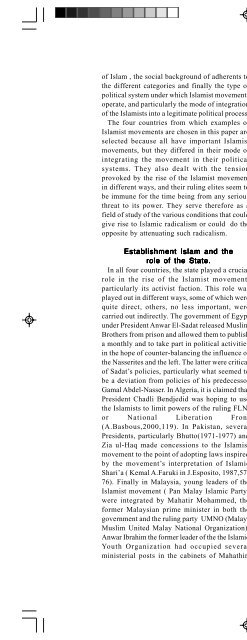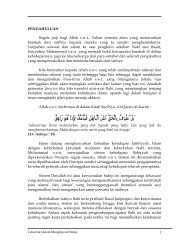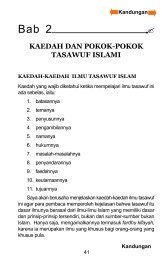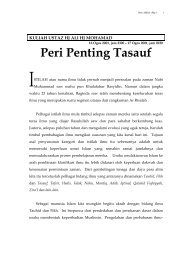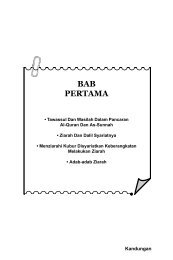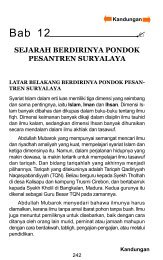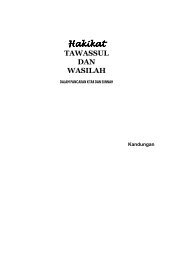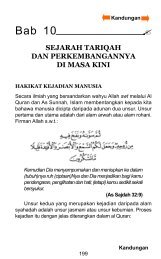inab3 cover front.psd - Khadijah Mosque
inab3 cover front.psd - Khadijah Mosque
inab3 cover front.psd - Khadijah Mosque
Create successful ePaper yourself
Turn your PDF publications into a flip-book with our unique Google optimized e-Paper software.
of Islam , the social background of adherents to<br />
the different categories and finally the type of<br />
political system under which Islamist movements<br />
operate, and particularly the mode of integration<br />
of the Islamists into a legitimate political process.<br />
The four countries from which examples of<br />
Islamist movements are chosen in this paper are<br />
selected because all have important Islamist<br />
movements, but they differed in their mode of<br />
integrating the movement in their political<br />
systems. They also dealt with the tension<br />
provoked by the rise of the Islamist movement<br />
in different ways, and their ruling elites seem to<br />
be immune for the time being from any serious<br />
threat to its power. They serve therefore as a<br />
field of study of the various conditions that could<br />
give rise to Islamic radicalism or could do the<br />
opposite by attenuating such radicalism.<br />
Establishment Islam and the<br />
role of the State.<br />
In all four countries, the state played a crucial<br />
role in the rise of the Islamist movement,<br />
particularly its activist faction. This role was<br />
played out in different ways, some of which were<br />
quite direct, others, no less important, were<br />
carried out indirectly. The government of Egypt<br />
under President Anwar El-Sadat released Muslim<br />
Brothers from prison and allowed them to publish<br />
a monthly and to take part in political activities<br />
in the hope of counter-balancing the influence of<br />
the Nasserites and the left. The latter were critical<br />
of Sadat’s policies, particularly what seemed to<br />
be a deviation from policies of his predecessor<br />
Gamal Abdel-Nasser. In Algeria, it is claimed that<br />
President Chadli Bendjedid was hoping to use<br />
the Islamists to limit powers of the ruling FLN,<br />
or National Liberation Front<br />
(A.Basbous,2000,119). In Pakistan, several<br />
Presidents, particularly Bhutto(1971-1977) and<br />
Zia ul-Haq made concessions to the Islamist<br />
movement to the point of adopting laws inspired<br />
by the movement’s interpretation of Islamic<br />
Shari’a ( Kemal A.Faruki in J.Esposito, 1987,57-<br />
76). Finally in Malaysia, young leaders of the<br />
Islamist movement ( Pan Malay Islamic Party)<br />
were integrated by Mahatir Mohammed, the<br />
former Malaysian prime minister in both the<br />
government and the ruling party UMNO (Malay-<br />
Muslim United Malay National Organization).<br />
Anwar Ibrahim the former leader of the the Islamic<br />
Youth Organization had occupied several<br />
ministerial posts in the cabinets of Mahathir,<br />
ranging from culture, youth and sport, agriculture,<br />
education and finally becoming vice-premier for<br />
the economy before his disgrace and trial<br />
immediately after the Asian financial crisis of 1997<br />
(F.V. Der Mehden in J.Esposito, 1987, 183).<br />
Besides, all four states helped the Islamists<br />
indirectly by accepting some of their demands.<br />
They thus introduced legislative measures and<br />
adopted policies in response to calls by Islamists.<br />
They accepted implicitly that part of the<br />
Islamists’ platform. President Sadat got the media<br />
to remind the Egyptian people that his name was<br />
Mohammed Anwar El-Sadat. He called himself<br />
the Pious President. He also coined the slogan<br />
that development of Egypt should be based on<br />
Science and Faith. One year before his<br />
assassination , he got the constitution of the<br />
country to be amended so that its second article<br />
would elevate principles of Islamic Shari’a to a<br />
basic source of legislation.<br />
In Algeria, Houary Boumediene, Algeria’s<br />
second president allowed the religious hierarchy<br />
to enjoy large influence within ministries of<br />
Education, Religious Affairs and Justice. His<br />
successor Shadli Benjedid introduced in 1984 a<br />
family code that reflected Islamists’ conservative<br />
interpretation of Islam on personal status matters<br />
(Basbous, OP.cit,142). A full program of<br />
Islamisation of state and society was gradually<br />
carried out in Pakistan under both Bhutto and<br />
Zia ul-Haq. In Malaysia , the government<br />
emphasized the Islamic character of the state in<br />
many ways. The Constitution of 1957 provided<br />
for Islam as a religion of the federation, the Sultan<br />
to be the head of Islamic religion, and protection<br />
of Muslims from proselytizing while allowing<br />
fro freedom of worship for other religions. Some<br />
states adopted statutes that punish Muslims for<br />
deviating from moral teachings of their religion.<br />
The Federal government attempted however to<br />
develop a synthesis between Islam and modern<br />
practices and institutions particularly in<br />
education and economic fields ( Der Mehden,<br />
op.cit.183-198).<br />
Governments of the four countries did not want<br />
to leave interpretation of Islam to be the<br />
monopoly of opposition groups that claim to be<br />
striving to build an authentic Islamic society. All<br />
had at their disposal religious institutions and<br />
members of the clergy who were willing to offer<br />
them , very often but not always , the kind of<br />
interpretation they like. The Egyptian<br />
government , under the monarchy before 1952<br />
Masjid <strong>Khadijah</strong> 73


